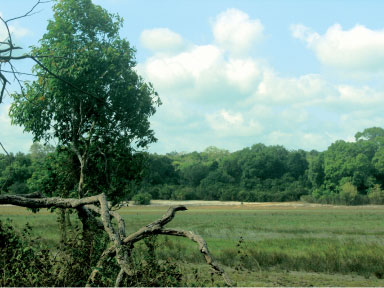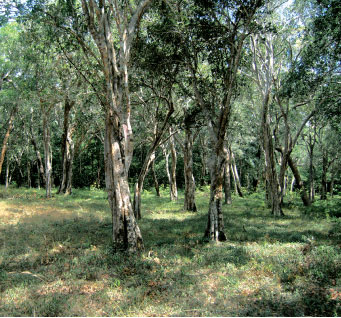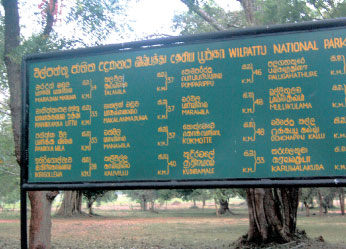 The way to Wilpattu! The way to Wilpattu!
by Nilma Dole
The safari ride to Wilpattu
National Park wasnít a very lively one as a majority of the beautiful
animals making it their home were quite frightened to see us
approaching. According to Wijekoon, our safari ranger, these animals
have been so stricken by war and destruction that everytime they see a
moving vehicle miles away from them, they would still flee in fear. It
was evident that despite the park now being open to visitors, itís
difficult to really get up close to view the animals in their natural
habitat.
Venturing on, we saw many jungle fowl, managed to spot a sloth bear
rustling in the bushes, a few peacocks and many birds of prey. Though,
the sambar deer and herd of wild boar started scampering for dear life
when we saw them from afar.
Wilpattu is so called because of the series of Willus or natural
lakes making it the Ďland of lakesí.
The landscaped water ponds and basins that have collected rainwater
decorated with soft sand look like something out of a picturesque
painting. Nestled in the northwest coast lowland or Sri Lanka in the dry
zone area, the entrance to the park is from Hunuwilagama at the 43rd
kilometre post off the Anuradhapura-Puttalam road.
The park has 131, 693 hectares, with a stupendous level of 0 to 152
meters above the sea. The park has about sixty lakes (willus) and tanks
that distributed all around Wilpattu offering a home and haven for its
nature-friendly residents. Wilpattu is one of the largest and oldest
national parks in Sri Lanka and possibly in the world, famous for its
Leopard (Panthera pardus kotiya) population. In 1905, the area was
designated a sanctuary and in 1938 it was upgraded to the national park
status.
There are 31 species of mammals that have been identified within
Wilpattu national park like the threatened species including elephant (Elephas
maximus), Sloth bear (Melursus ursinus), leopard (Panthera pardus kotiya)
and water Buffalo (Bubalus bubalis). Sambhur, spotted deer, mongoose,
mouse and shrew are also in existence.
 The painted stork, the open bill, little cormorant, along with many
species of owls, terns, gulls, eagles, kites buzzards are to be found at
Wilpattu National Park. The painted stork, the open bill, little cormorant, along with many
species of owls, terns, gulls, eagles, kites buzzards are to be found at
Wilpattu National Park.
Wetland bird species that can be senn in Wilpattu are the garganey (Anas
querquedula), pin tail (Anas acuta), whistling teal (Dendrocygna
javanica), spoonbill (Platalea leucorodia), white ibis (Threskiornis
malanocephalus), large white egret (Egretta alba modesta), cattle egret
(Bubulcus ibis) and purple heron (Ardea purpurea). The most common
reptiles found in the park are the monitor lizard(Varanus bengalensis),
mugger crocodile (Crocodylus palustris), common cobra (Naja naja), rat
snake (Ptyas mucosus), Indian python (Python molurus), pond turtle (Melanonchelys
trijuga) and the soft shelled turtle (Lissemys punctata) making their
homes in the bigger villus.
From December 1988 to March 16, 2003 the park was closed due to the
war situation and thereafter, nearly 16 years later, it was reopened.
Visitors can currently only tour some 25% (75% of the park is dense
forest or scrub) of the park. The best time to visit Wilpattu is during
the months of February and October. Upon visiting the park, you can even
see some of the claymore bomb attack that befell the late great writer
Nihal de Silva which is marked by some shrapnel and army vest.
The Mahavansa indicates that in 543 BC, Prince Vijaya was washed
ashore at the Kudrimalai Point (Horse Point), married Kuweni and founded
the Sinhalese race. Hence, you can see the ancient remains of Kuveniís
Palace when you venture inside the park.
Sadly, we didnít see a leopard when we went due to the problem of it
going into hiding. Part of the reason is that the animals are still in
fear in the aftermath of the war.
 According to the ranger, he said that there have been certain
activities in order to make the park safe so that visitors wonít be at a
risk on the track. In lieu of this, we noticed that the roof of the
safari jeep was tightly secured so that you couldnít stand up and this
was also a safety measure taken by the warden for fear of animal attack. According to the ranger, he said that there have been certain
activities in order to make the park safe so that visitors wonít be at a
risk on the track. In lieu of this, we noticed that the roof of the
safari jeep was tightly secured so that you couldnít stand up and this
was also a safety measure taken by the warden for fear of animal attack.
However, we didnít even see animals getting close to us since they
were scared already. Also, we noticed soldiers from the army camp doing
their morning exercises which actually disturbed the tranquility of the
park with their jogging and chatting noises.
So there is really no peace for these animals! The bungalows within
the park have been built for the use of special officials and are
undergoing reconstruction after it has become safe after the dawn of
peace.
Though, Wilpattu is definitely worth the visit because of its beauty
and lure! |

